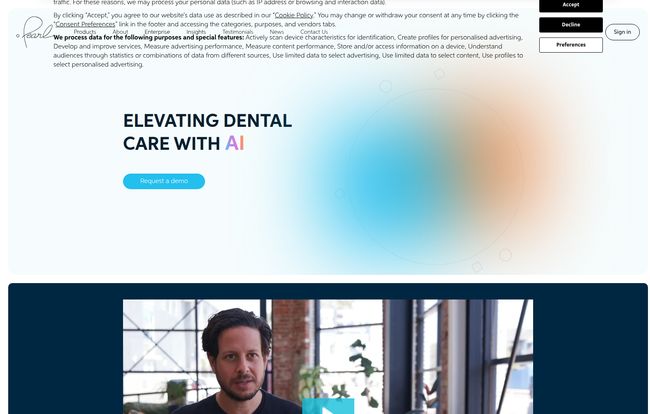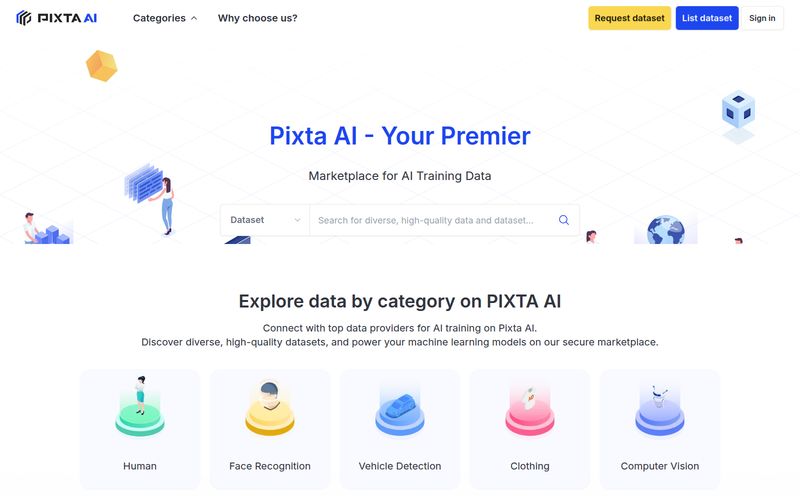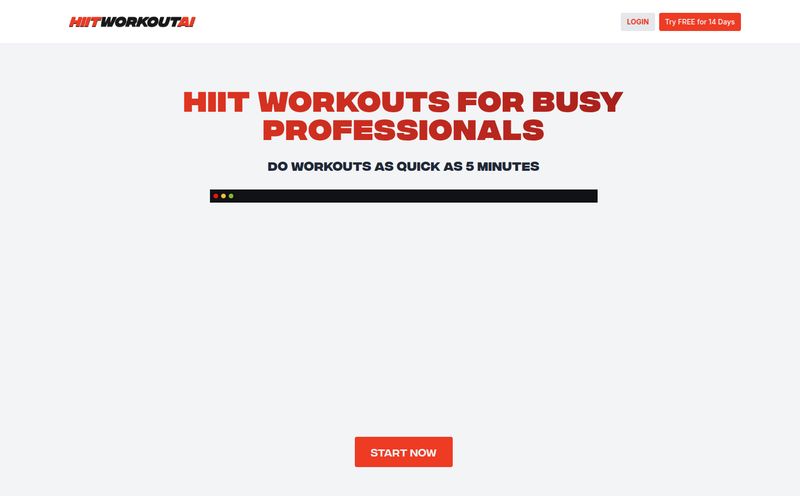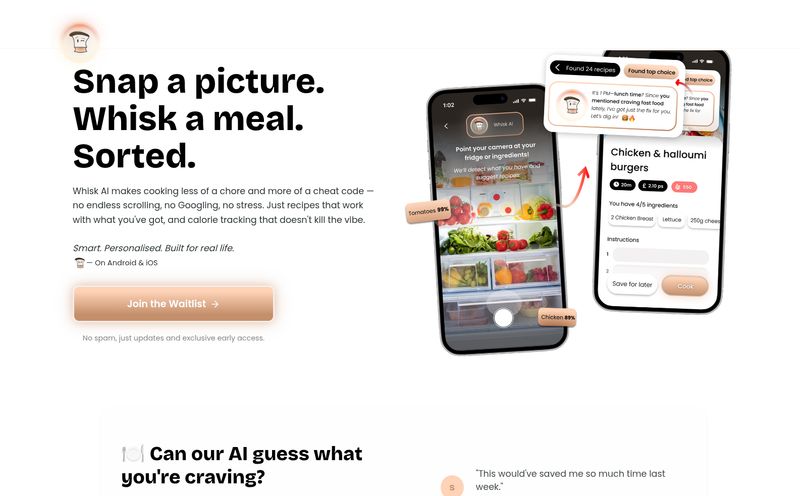For years, we've been hearing about AI coming for everyone's jobs. First it was writers, then artists, and now... dentists? Not quite. But the world of dental technology is definitely getting a massive upgrade, and I’ve been keeping a close eye on a company that’s making some serious waves: Pearl.
I spend my days swimming in data, trends, and traffic, so when a tool promises to revolutionize an entire industry's workflow, my curiosity gets piqued. We've all been there, right? Sitting in the dentist's chair, squinting at a dark little film, while the doctor says, “See that tiny shadow right there?” And you just nod, pretending you see anything other than a Rorschach test of your dental anxieties.
This is the communication gap Pearl aims to bridge. It’s not about replacing the dentist; it’s about giving them—and you—a clearer picture. Literally.
So, What Exactly is Pearl AI?
At its core, Pearl is an artificial intelligence platform designed to be a dentist’s co-pilot. It uses machine learning and some seriously slick computer vision to analyze dental radiographs (that’s X-rays to you and me) in real-time. Think of it as a super-powered second opinion that’s available instantly.
The company has a whole suite of solutions, but their flagship product, Second Opinion®, is the one getting a lot of buzz. It’s FDA-cleared to detect a whole range of potential issues in dental x-rays. We’re talking caries (cavities), calculus (tartar), faulty restorations, bone loss... the whole gamut of things you'd rather not have.
This isn't just some beta-test software. Pearl is legit. They have regulatory clearance in over 100 countries, which is no small feat in the medical world. They're not just a startup with a cool idea; they're a global player.
How Does This AI Magic Actually Work?
It's easy to throw around terms like “machine learning,” but what's happening under the hood? Pearl breaks it down into a few key steps that turn a standard X-ray into a powerful diagnostic and communication tool.
More Than Just a Pretty Picture: AI Enhancement & Segmentation
First off, the AI doesn’t just look at the image your sensor captures. It enhances it, sharpening details and improving clarity. Then comes the segmentation. The AI meticulously outlines individual teeth, roots, crowns, and the surrounding anatomy. It’s like creating a precise digital map of the patient’s mouth before it even starts looking for trouble.
The “Aha!” Moment: Detection and Measurement
This is where the real power lies. Trained on what Pearl claims is the world's largest collection of expertly annotated radiographs, the AI scans the mapped-out image. When it finds a potential issue—say, a nascent cavity between two molars—it highlights it directly on the screen. It can even measure things like the size of a lesion or the extent of bone loss. This is a game-changer. Suddenly, that vague “little shadow” becomes a clearly outlined, color-coded area that both dentist and patient can see and understand instantly.

Visit Pearl
The Real-World Benefits for Your Dental Practice
Okay, the tech is cool. But as a practice owner or a dentist, you're asking: what's the ROI? How does this actually help my business and my patients?
Building Unshakeable Patient Trust
I think this is the most underrated benefit. Patient trust is the currency of any medical practice. When a patient can visually see the AI's findings backing up your diagnosis, it changes the conversation. It moves from “The doctor says I need a filling” to “I can see the problem we need to fix.”
Dr. Kunal Patel of Love Teeth Dental Practices put it perfectly: “Second Opinion is so great for me because it's the ideal workflow to go from the patient chair to the consult room and have it available for speaking to them.”
It transforms the X-ray from a clinical tool for the doctor into an educational tool for the patient. That’s huge for case acceptance and building long-term relationships.
A Boost to Efficiency and Accuracy
Consistency is another massive win, especially for group practices. With multiple associates, there can be slight variations in how radiographs are interpreted. Pearl acts as a standardized baseline, ensuring that every X-ray gets the same meticulous level of scrutiny. This leads to more consistent diagnoses and treatment plans across the board. Plus, the system includes tools for AI-powered insurance verification, which can save your front-office staff a mountain of administrative headaches.
But Is It Really Perfect? A Candid Look at the Limitations
Now, as an analyst, I’m naturally skeptical. No tool is a silver bullet. While Pearl is incredibly impressive, there are a few things to keep in mind. Let's get real for a second.
The company's own information mentions that for some of its advanced features, there’s a minimum patient age of 12. This is a practical consideration. Interestingly, their marketing also highlights that their core AI is trained on patient data as young as 4, which they position as an advantage over competitors. So there's a bit of nuance there—the core detection might be broader, while specific, FDA-cleared features have tighter parameters. It's something a pediatric-focused practice would need to clarify during a demo.
There's also a mention of X-ray support being limited to bitewing and periapical images for some features. For most general dentistry, that’s your bread and butter anyway, but if your practice relies heavily on panoramic or other types of radiographs, you’d want to confirm full compatibility for your specific needs.
The Big Question: What Does Pearl AI Cost?
Ah, the million-dollar question. Or, hopefully, a lot less. If you browse Pearl’s website, you won’t find a pricing page. This is pretty standard for high-level B2B and medical-grade software. Pricing is likely customized based on the size of your practice, the number of users, and the specific solutions you need (e.g., just the clinical AI or the insurance tools as well).
Your path to getting a price tag will be to “Request a Demo.” Don’t let that scare you. It’s an opportunity to see the software in action and ask those very specific questions about age limitations and X-ray types. It ensures you’re getting a solution that actually fits you practice.
Frequently Asked Questions about Pearl Dental AI
Is Pearl AI actually FDA-cleared?
Yes, absolutely. Its Second Opinion® and other solutions have received FDA clearance, in addition to regulatory approvals in over 100 other countries. This is a major mark of credibility.
Will this kind of AI replace dentists?
Not a chance. It's designed as an assistive tool, a second set of eyes to enhance a dentist's own professional judgment. The final diagnosis and treatment plan always rest with the human expert.
What kind of dental problems can Pearl detect?
It’s trained to identify a wide range of common and subtle pathologies, including cavities (caries), tartar (calculus), bone loss, abscesses, and issues with existing restorations like crowns and fillings.
Is Pearl difficult to integrate into an existing practice?
Based on testimonials, the workflow seems designed to be smooth. It integrates with existing radiographic systems to provide its analysis in near real-time, aiming to fit into the natural flow from patient chair to consultation.
Who is the ideal user for Pearl?
Pearl has solutions tailored for different parts of the dental ecosystem, including solo dental clinics, large group practices (DSOs), dental labs, and even insurance companies looking to streamline claim reviews.
My Final Thoughts on Pearl
After looking at the tech, the testimonials, and the market positioning, I'm genuinely impressed with what Pearl is doing. They aren’t just selling software; they’re selling confidence. Confidence for the dentist in their diagnosis, and confidence for the patient in their treatment plan.
The use of that massive, proprietary dataset for training is their secret sauce, giving them a clinical edge that’s hard to replicate. While it's not a magical fix-all, and practices need to do their due diligence, Pearl represents a significant step forward. It’s making dental care more objective, transparent, and consistent. And in an industry built on trust, that’s a pretty powerful thing.
References and Sources
- The official Pearl Website: www.hellopearl.com
- ADA News, "ADA adopts policy on artificial intelligence": https://www.ada.org/publications/ada-news/2023/october/ada-adopts-policy-on-artificial-intelligence



